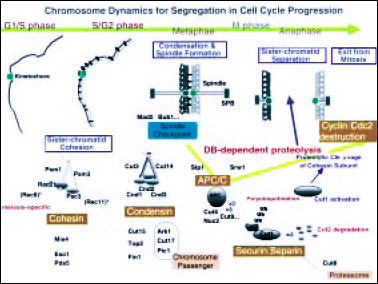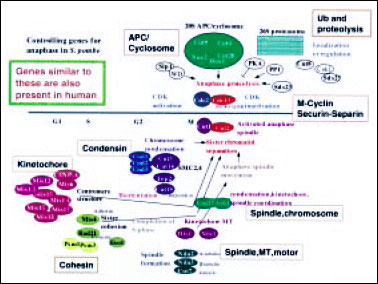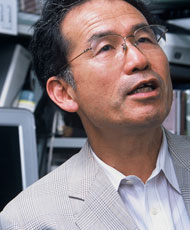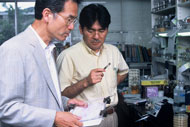Basis of Life Inheritance: How are chromosomes in a mother cell correctly segregated into two daughter cells?
- The Regulation of Cell Cycle and Chromosome Segregation -
When I was a graduate student of the University of Tokyo in the early sixties, I dreamt of being a laboratory head in the future, and of studying the molecular biology of the chromosome. At the time the chromosome looked a challengingly complex biological structure. It was many years before I had the chance to work on an actual chromosome, as I spent ten years studying a model structure, the head of the bacteriophage T4. In recollection, it was an excellent experience to engage in the study of a pure model organism; fellow investigators were friendly and helpful, and there was a warm comradeship between us. In truth however, the head of T4 shares no common features with the eukaryotic chromosome, except for the fact that it consists of many proteins and condensed DNA. What I learned from T4 was the strategy of dissecting biological problems into molecular terms. When I was promoted to a professor of Kyoto University in 1977, I had full enthusiasm to tackle the chromosome structure and the regulation of its behaviour that was kept in my mind for so many years.
Which eukaryotic organism should I choose to study the chromosome? This was not an easy decision to make. The organism had to be amenable for detailed genetic and biochemical analysis. Protozoan Chlamydomonas and yeast Saccharomyces were possible choices, but I was not convinced for various reasons. One day, Masayuki Yamamoto, who later joined our research team, showed me a review article describing biological characteristics of the fission yeast Schizosaccharomyces pombe. After reading this article and other related ones that night, I firmly believed that this was the organism that I had been looking for. The decision to work on S. pombe was like an impulsive purchase of a new house, as I knew my life for the next twenty-five years should be strongly influenced by it. Luckily, I have been perfectly happy with the outcome of this "impulsive purchase".
While chromosome DNA replicates at a cell division cycle stage called the 'Sphase', the resulting chromosomes, which contain two duplex DNA (sister chromatids), are separated and segregated by the spindle apparatus in a different cell cycle stage called the 'M-phase' (Figure1). Therefore chromosome segregation is a part of the cell cycle mechanism. The M-phase could be described as a 'cell festival', as cells become agitated, and many unusual structures appear within the cell. Spectacular chromosome and spindle events occur very swiftly, leading to the culmination of fast sister chromatid separation in the anaphase.

Figure 1 : Chromosome segregation in cell cycle progression
The high fidelity segregation of chromosomes is fundamental for cell multiplication, and cells are able to manage the control of chromosome behaviour in the M-phase with surprisingly high precision. If segregation becomes abnormal by mutation, drug, radiation or stress, cells become lethal or aneuploid, leading to various diseases in human such as Down syndrome, or more commonly natural abortion. Many researchers suspect that early cancerous cells contain abnormally segregated chromosomes.
My laboratory group has made a systematic approach to develop our understanding of the molecular mechanisms for regulation of cell cycle and chromosome segregation. A large number of mutants defective in chromosome segregation have been isolated, and their genes have been identified by cloning and sequencing. The function of gene products (such as proteins) essential for sister chromatid separation have been pursued by various cellular and molecular approaches. The interactions among these gene products and their roles in cell cycle regulations have also been investigated. With the use of these mutants and identification of various essential proteins, our research areas have become inevitably very broad.
Many proteins such as DNA topoisomerase II, condensin, cohesin, tubulin and kinesin were found to be required for proper chromosome structure and spindle formation in the M-phase(Figure2). Furthermore, several kinetochore proteins were discovered and their functions were shown to be essential for equal chromosome segregation. Other essential components discovered include the subunits of APC/cyclosome, the regulator of proteasome and serine/threonine protein phosphatase 1 (PP1).

Figure 2 : Proteins for proper chromosome structure and spindle formation in the M-phase
I have to admit that in the beginning I was rather uninformed about protein dephosphorylation and ubiquitin-mediated proteolysis. I was unaware of the very existence of many protein phosphatases that later became favourite research projects in my laboratory.
While initially I was an inattentive listener of proteolysis talks in meetings, I was surprised to find that some gene products identified in my lab were very important and extremely interesting, and turned out to be the components essential for ubiquitin-mediated proteolysis. Naturally, we were dismayed by other research groups' discovery that several mutants we were very much interested in were actually defective in the destruction-box dependent polyubiquitination of mitotic cyclin. We missed the existence of an APC/cyclosome complex essential for this step. We were, however, fortunate to discover that the separase-securin (Cut1-Cut2 protein) complex plays a pivotal role for coordination between sister chromatid separation and cell cycle control. We found that securin/Cut2 is ubiquitinated by APC/cyclosome and degraded by a proteasome complex at the onset of sister chromatid separation. If securin/Cut2 is not degraded, the sister chromatids are not separated. Separase/Cut1 is activated when securin is degraded. It was a most rewarding breakthrough to discover that the mode of destruction for securin/Cut2 is the same as that of the mitotic cyclin, a key regulator of the cell cycle. This discovery demonstrated the mechanism by which sister chromatid separation coordinates with the timing of mitotic exit. Kim Nasmyth and Frank Uhlmann showed that budding yeast separase/Esp1 has actual protease activity and cleaves cohesin subunit Scc1, a structure that adheres sister chromatids together. Thus, there are two steps of proteolysis that promotesister chromatid separation. The first proteolysis step is a destruction-box dependent and ubiquitin-mediated securin destruction that activates separase. The second proteolysis step is the separase-dependent cleavage of cohesin that releases the bonding of sister chromatids.
A solid foundation is now placed for understanding complex molecular processes that lead to chromosome separation and segregation in mitosis. However, our knowledge of the mechanism of chromosome dynamics during the cell cycle is still limited. We may be looking at only the tip of an iceberg. The principle of chromosome inheritance is conserved from yeast to human. As chromosomes are the actual substance of a genome, and transmission of chromosomes from one cell to another is the basis for life inheritance, chromosome biology will become increasingly more important. We can expect many surprising findings to come in the future.

Mitsuhiro Yanagida
Born in 1941.
Graduate of the master's program, Graduate
School of Science,The University of Tokyo
D.Sc., The University of Tokyo
Professor, Graduate School of Biostudies, Kyoto University
"It seems to me that on the whole, Japan's intellectual community has been terribly insensitive to issues of bioethics. I can see no recognition, at any level, that we should help persons in weaker and less fortunate circumstances than ourselves."
Kyoto University has a bad reputation among foreign students: these are the first words out of the mouth of very likable Professor Yanagida. And, having repeatedly made this declaration on important occasions, in accordance with his own firmly held system of values, it seems that he cannot ignore this reality. At the same time, he raises the possibility that total end-to-end support may not, in fact, be in the best interests of the foreign students themselves after all. He emphasizes the necessity for the university to have an overall vision of how it will deal with these students. His view of the lack of consideration for minorities that underlies this problem is unrelenting in its severity. One can sense it regardless of whether he speaks of problems in education at the university, or of the state of our society and how it effects his own field of natural science research. He maintains a certain distance between himself and the worldly acclaim his research findings have received, in the form of numerous awards, by saying, "The way I view my work is not the same as how others view it." At the same time, however, on his own initiative he warns of the lack of consideration, in both Japan's science and technology policy and its society as a whole, for persons in weaker and less fortunate circumstances. In Prof. Yanagida, one has a sense of what might be one sort of idealized relationship between scientists and society at-large.

In the laboratory, Prof. Yanagida receives reports from students on the results of their experiments.

